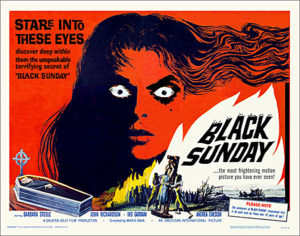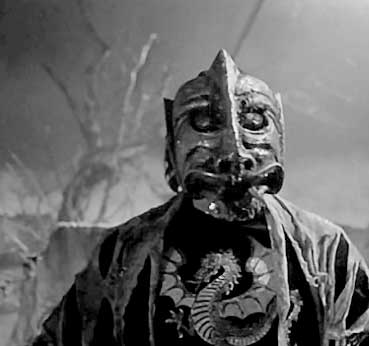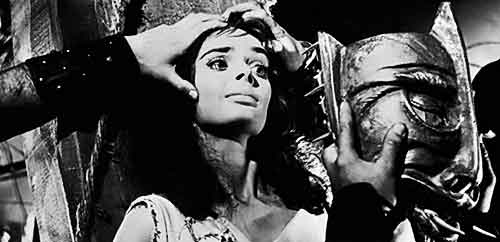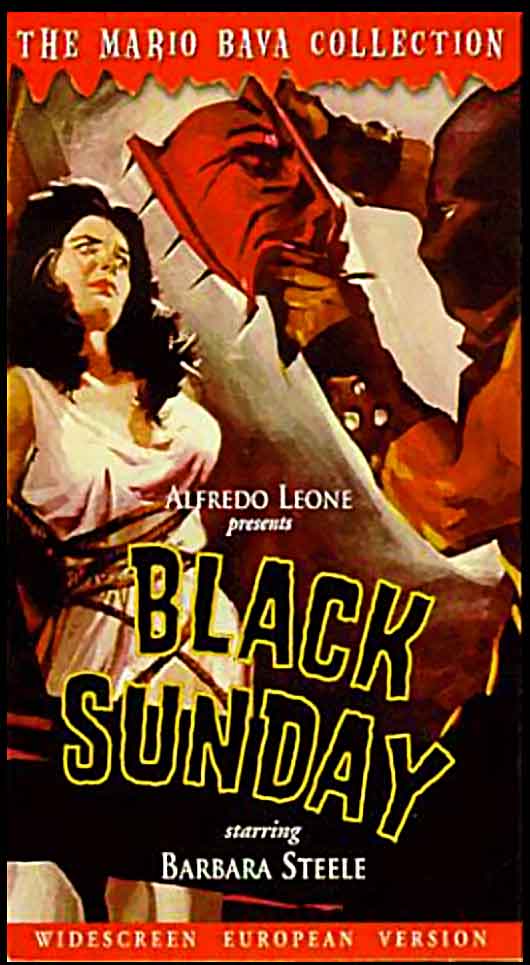 This was the first solo-directed film by the great Mario Bava, and remains his best-known work. There’s an excellent reason for that, and for the fact that actress Barbara Steele became a horror icon based on her performance in BLACK SUNDAY.
This was the first solo-directed film by the great Mario Bava, and remains his best-known work. There’s an excellent reason for that, and for the fact that actress Barbara Steele became a horror icon based on her performance in BLACK SUNDAY.
The onscreen title of the current DVD release of this 1961 film is THE MASK OF SATAN (or LA MASCHERA DEL DEMONIO). It has, however, become better known over the years as BLACK SUNDAY, the title grafted onto its original US release by American International Pictures, who also cut approximately three minutes of footage that’s since been restored.
Mario Bava was making his directorial debut (at age 46!) after years of photographing and making uncredited directorial contributions to other filmmakers’ work (such as I, VAMPIRI and CALTICKI THE IMMORTAL MONSTER). BLACK SUNDAY was a worldwide success, dripping as it was with gothic atmosphere, ahead-of-its-time gore and the incandescent Barbara Steele, who’d scuttled her Hollywood career by walking off the set of the 1960 Elvis Presley headliner THE FLAMING STAR. Steele relocated to Italy and was immediately cast in BLACK SUNDAY, which solidified her status as a Euro horror movie icon (subsequent Steele projects included THE PIT AND THE PENDULUM, 1962, THE HORRIBLE DR. HITCHCOCK, 1962, THE GHOST, 1963, NIGHTMARE CASTLE, 1965, and SHIVERS, 1975). As for Bava, he’d go on to become one of the world’s finest and most prolific horror specialists with THE EVIL EYE (1962), BLACK SABBATH (1963), BLOOD AND BLACK LACE (1964), THE WHIP AND THE BODY (1963), TWITCH OF THE DEATH NERVE (1971), LISA AND THE DEVIL (1973) and many more unforgettable films.
In the Russian province of Moldavia sometime during the Seventeenth Century the beautiful but corrupt Princess Asa is put to death for witchcraft—by having a mask with sharp spikes inside it literally pounded onto her face. Asa’s brother, the Prince Igor Javutich, is also executed, and the two are then interred in a crypt underneath the family castle. Two hundred years later their resting place is breached by two overly inquisitive doctors: Grobec and Krubayon, who cuts himself on a sharp edge of Asa’s tomb and bleeds on her corpse. This blood is enough to revive her, and allow Asa to commence a reign of terror without ever once leaving her tomb! She sends her resurrected bro Javutich into the castle to induct warm bodies, dragging men into the cellar where Asa deals them an undead kiss that turns ‘em into zombies.
Asa’s target is Princess Katia, her look-alike descendant with whom Asa plans to switch bodies. Standing in her way are Grobec and Krubayon, who find themselves becoming increasingly involved in Katia’s affairs: Krubayon, after all, has fallen in love with Katia and will do anything to help avert her horrific destiny. When a secret passageway is discovered leading from the castle’s living room into Asa’s shadowy domain, Grobec, Krubayon and Katia see a prime opportunity to end Asa’s reign of terror forever.
Mario Bava was first and foremost a great visualist, evident in BLACK SUNDAY’S superbly shadowy black and white photography, which remains among the finest of any movie in any genre. What gives it its punch is the fact that Bava, despite being fully aware he was shooting in black and white, actually used multi-colored filters in lighting the film, which gives it a unique look. As he would on most of his subsequent films, Bava acted as his own cinematographer, and simply could not have shot a better-looking film. His also made a perfect choice casting Barbara Steele in the main role, who in addition to her near-unearthly beauty has a genuinely gothic aura.
Another asset is the startling grue, which, while no longer particularly traumatizing, was quite potent for its time. In retrospect the film can be viewed as a bridge between the stately Universal horror movies of the thirties and forties and the more graphic fare of the late sixties and seventies.
What the film lacks is a compelling story. The script cobbled together by Bava and his collaborators was allegedly based on Nikolai Gogol’s story “The Vij”, but it’s impossible to tell from the results, which are jumbled and often incoherent; I’ve seen the film several times and listened to Tim Lucas’ erudite DVD commentary, yet am still unclear on quite a few plot points.
There’s another problem, one afflicting quite a few horror films past and present: quite simply, the living and breathing protagonists are all terminally uninteresting. This makes it all-but impossible not to root for the undead baddies, led by the seductive Princess Asa, who unlike her antagonists at least has a coherent goal…and is much better looking.
Vital Statistics
BLACK SUNDAY (a.k.a. THE MASK OF SATAN)
Galatea-Jolly Film Productions
Director: Mario Bava
Producer: Massimo de Rita
Screenplay: Ennio De Concini, Mario Serandrei
(Based on a story by Nikolai Gogol)
Cinematography: Mario Bava
Editing: Mario Serandrei
Cast: Barbara Steele, John Richardson, Ivo Garrani, Andrea Checchi, Arturo Dominici, Enrico Olivieri, Antonio Pierfederici, Tino Bianchi, Clara Bindi, Mario Passante



